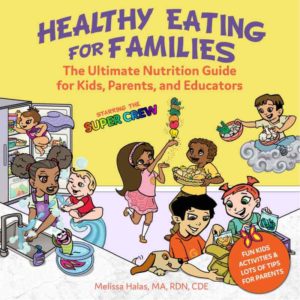
Children's nutrition is an issue of great importance, but not everyone knows how to help them understand it. You can start by giving small amounts of new foods to your children. Children should start with small amounts of food, such as broccoli. Then they can move on to larger portions. If they enjoy a food they will continue to eat it. It is important to limit the amount of food they eat at once.
A newsletter from a pediatrician is a great resource for parents looking for nutrition information. They also offer research articles, seminars, and other information. You can also sign up for the newsletter. The center also offers healthy eating posters and a newsletter. It is one eight federally funded centers that are dedicated to improving the nutrition of children. The Baylor College of Medicine is responsible for the operation of the center. The guide contains links to resources that can be used by health professionals. Separate briefs offer resources for families and schools.

Healthy fats are essential for a healthy diet. These fats are found primarily in nuts, seafood, and vegetables. Choose low-fat, fat-free varieties of dairy products for children and limit fried foods. You can also include grains in your child’s diet. Whole-wheat bread is best, but you can also try brown rice or whole-wheat bread. White bread substituted for grains can lead to obesity or blood sugar problems in children.
Children's nutrition should also include fruits. Fresh fruits are best, but dried fruits are also healthy. These fruits can also add calories. You should always read nutrition labels on packaged foods. You can choose a variety of fruit and vegetables based on their age and liking. You don't have to be specific about the fruits that your child likes. As long as there is no sugar added, you can mix them up in small amounts.
Children's nutrition is especially important for academic and physical success. How they eat can have a significant impact on their health, and this is crucial for their physical development. The right nutrition is essential for a child’s development. Children will be stronger and healthier if they eat healthy foods. You should make sure that they get enough nutrients to grow healthy. This is one of the most important parts of your child's diet.

When it comes to children's nutrition, the best way to start is to offer them nutritious foods as part of every meal. Some examples of these foods are colorful fruits and vegetables, and they should be accompanied by healthy foods. For your child’s health, it is important to eat a balanced diet. For example, children should eat plenty of fruits & vegetables. You can help your child meet his nutritional needs by adding fruits or vegetables to his meals.
FAQ
What is the difference between a calorie or a kilocalorie.
Calories are units that measure how much food has energy. The unit of measurement is called a calorie. One calorie contains the energy needed to raise the temperature of one gram of water by one degree Celsius.
Kilocalories refer to calories in another term. Kilocalories are expressed in thousandths (or a calorie). 1000 calories, for example, equals one kilocalorie.
How can you live a healthy life?
Living a healthy lifestyle includes eating right, exercising regularly, getting enough sleep, managing stress, and having fun! Eating well means avoiding processed foods, sugar, and unhealthy fats. Exercise can help you burn calories and strengthen your muscles. Sleeping well improves concentration and memory. Stress management can reduce anxiety and depression. Fun is the key to keeping us healthy and happy.
What should I eat?
Get lots of fruits & vegetables. These fruits and vegetables are high in vitamins, minerals, which can help you keep your immune systems strong. Additionally, vegetables and fruits are high fiber. This helps with digestion and keeps them full. Try to include at least five servings of fruit and veg per day.
Get plenty of water. Water flushes toxins from the body and gives you a full feeling between meals. Drink about eight glasses each day.
Whole grains are better than refined ones. Whole grains are rich in nutrients such as iron, zinc and magnesium. Refined grain has lost some of its nutrition.
Avoid sugary drinks. Sugary drinks are loaded with empty calories and contribute to obesity. Instead, opt for water, milk, or unsweetened tea.
Avoid fast food. Fast food has very little nutritional value. While it might taste good, it won't give your body the energy it needs to function properly. Stick to healthier options such as salads, soups, sandwiches, and pasta dishes.
Reduce your alcohol intake. Alcohol contains empty calories and contributes to poor nutrition. Limit your consumption to no more than 2 alcoholic beverages per week
Red meat should be cut down. Red meats are high in saturated fat and cholesterol. Instead, choose lean cuts of beef and pork, lamb, chicken or fish.
What are 10 healthy habits?
-
Get breakfast every morning.
-
Don't skip meals.
-
Eat a balanced, healthy diet.
-
Get plenty of water.
-
Take care of your body.
-
Get enough sleep.
-
Stay away from junk foods.
-
Do some exercise every day.
-
Have fun
-
Meet new people.
How often should I exercise
It is important to exercise for a healthy lifestyle. There is no time limit on how much you should exercise. Finding something that you love and sticking with it is the key.
If you work out three times a week, then aim to complete 20-30 minutes of moderate intensity physical activity. Moderate intensity means you'll still be breathing hard after you've finished. This type workout burns about 300 calories.
You can walk for 10 minutes every day if that is what you prefer. Walking is low impact and easy on your joints.
Jogging three times a week for 15 mins is enough if you want to run. Running is a great way to burn off excess calories and build muscle tone.
You can start slow if you're new to exercise. Start by doing 5 minutes of cardio each day, a few times per week. Gradually increase the time you do cardio until your goal is reached.
Is it possible to have a weak immune system due to being cold?
There are two types of people in the world: those who love winter and those that hate it. It doesn't matter if you love it or not, it is possible to wonder why it makes you feel so miserable when it gets cold outside.
The answer lies in the fact that our bodies are designed to function best during warm weather. Hot climates are where our food sources are most plentiful, and we evolved to thrive there.
We live in a very different environment than our ancestors. We spend more time indoors, are exposed to extreme temperatures (cold/heat), and eat processed food rather than fresh.
As a result, our bodies aren't used to such extremes anymore. It means that when we do go outdoors, we are often tired, sluggish or even sick.
However, there are ways to counter these effects. You can combat these effects by making sure you are well-hydrated all day. You can help flush toxins out of your body by drinking plenty of water.
It is important to eat healthy foods. Consuming healthy food helps maintain your body's optimal temperature. This is especially beneficial for those who spend extended periods of time inside.
Finally, consider taking a few minutes each morning to meditate. Meditation is a great way to relax your body and mind. It makes it easier for you to cope with stress and illness.
Statistics
- WHO recommends reducing saturated fats to less than 10% of total energy intake; reducing trans-fats to less than 1% of total energy intake; and replacing both saturated fats and trans-fats to unsaturated fats. (who.int)
- WHO recommends consuming less than 5% of total energy intake for additional health benefits. (who.int)
- According to the Physical Activity Guidelines for Americans, we should strive for at least 150 minutes of moderate intensity activity each week (54Trusted Source Smoking, harmful use of drugs, and alcohol abuse can all seriously negatively affect your health. (healthline.com)
- The Dietary Guidelines for Americans recommend keeping added sugar intake below 10% of your daily calorie intake, while the World Health Organization recommends slashing added sugars to 5% or less of your daily calories for optimal health (59Trusted (healthline.com)
External Links
How To
What does "vitamin" actually mean?
Vitamins are organic compounds naturally found in food. Vitamins aid us in absorbing nutrients from the food we eat. Vitamins are not made by the body, so they must be obtained through food.
There are two types if vitamins: water soluble, and fat soluble. Water-soluble vitamins dissolve easily when they are dissolved in water. Vitamin C,B1(thiamine), B2 (2riboflavin), and B3 (3niacin), as well as vitamin C,B1, B2 (riboflavin), and B3 (niacin), vitamin B6 (pyridoxine), vitamin folic acid (biotin), pantothenic, and choline are examples. Fat soluble vitamins are stored in the liver and fatty tissue. Vitamin D, E, K and A are some examples.
Vitamins are classified according their biological activity. There are eight main groups of vitamins.
-
A - Vital for normal growth and maintaining good health.
-
C - vital for proper nerve function, and energy production.
-
D – Essential for healthy teeth, bones and joints
-
E - needed for good vision and reproduction.
-
K – Required for healthy nerves & muscles.
-
P - vital for building strong bones andteeth.
-
Q - Aids digestion and iron absorption
-
R - Required for red blood cell production
The recommended daily allowance (RDA), for vitamins, varies depending upon age, gender, or physical condition. The U.S. Food and Drug Administration has established the RDA values.
For adults over 19, the RDA for vitaminA is 400 micrograms per daily. Because it is essential for the development of the fetus, pregnant women should consume 600 micrograms per daily. Children ages 1-8 require 900 micrograms per day. Infants below one year old require 700mg per day. But, between 9 months to 12 months, the amount drops to 500mg per day.
Children aged between 1-18 years require 800 micrograms of sugar per day, while overweight children need 1000 micrograms. Children who are underweight receive 1200 micrograms every day to meet their nutritional requirements.
Children ages 4-8 years who have been diagnosed with anemia need 2200 micrograms per day of vitamin C.
2000 micrograms per person is necessary for general health. Due to their increased nutrient needs, pregnant and breastfeeding women need 3000 micrograms daily.
1500 micrograms is the recommended daily intake for adults aged 70+, who lose approximately 10% of muscle each year.
Women who have been pregnant or are lactating require more than the RDA. Pregnant woman need 4000 micrograms daily in pregnancy, and 2500 per day after childbirth. Breastfeeding moms need 5000 micrograms each day when breastmilk production occurs.